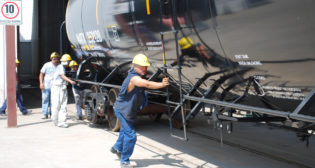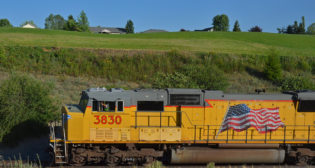
Freight car market: “Railroads will continue to support demand”
Written by William C. Vantuono, Editor-in-ChiefEconomic Planning Associates has released its first-quarter 2012 report on the freight car market, and while there has been a decline in carbuilder backlogs, EPA has not measurably changed its forecast since its last report. EPA noted that “the railroads will continue to support demand for railcars.”
“Incoming orders of 12,500 cars and assemblies of 16,800 cars have resulted in a modest decline of 4,400 units in the backlogs during the first quarter. At the current production rate, carbuilders still have 3.6 quarters of deliveries in their backlogs.”
The pace of carbuilding will begin to pick up appreciably after next year, EPA said: “Based on first quarter assemblies and current backlogs, our 2012 estimate of 58,000 railcar deliveries is unchanged from our last report. Next year, a slowing in the recent frenetic production pace of small cube covered hoppers will moderate the growth in deliveries to 59,000 units, before there is a modest easing to 57,500 deliveries in 2014. After 2013, we look for railcar demand to remain at high annual levels. From 57,500 deliveries in 2014, railcar assemblies will gradually move up to 60,300 units in 2017.
There are many factors influencing the freight car market. According to EPA:
“We are concerned about the underwhelming growth of the economy as manufacturers, oil and gas producers, and coal companies struggle with the increasing number of government regulations that are dampening our economic potential. We have noticed that our GDP growth has slipped from 3.0% in the fourth quarter to 2.2% in this year’s opening quarter. Hopefully, our economy can eventually embark on a stronger path of growth, which will improve railroad traffic, revenue, and investments, leading to continued healthy growth in railcar demand.
“Tank cars continued to lead the parade in demand for new rolling stock. In spite of an acceleration in assemblies, first quarter orders of 6,479 cars brought backlogs at the end of March to 32,843 units, more than 9 quarters of current production rates.
“While orders for small cube covered hoppers moderated, first quarter assemblies of 5,134 cars and backlogs of 9,131 cars ensures a healthy level of deliveries this year while continued growth in oil and gas exploration should keep deliveries at a high level next year.
“Boxcar demand has been rising as TTX upgrades its aged 50- and 60-foot general service cars. At the same time, the three year rise in manufacturing activities has prompted strong growth in mill gondolas and steel coil cars which should translate into healthy levels of deliveries this year and next.
“Coal consumption by the utilities has been dampened by warm winter weather and stiff competition from natural gas as a fuel source for the generation of electricity. As a result, first quarter orders for GT gondolas and hoppers were extremely weak. We expect some improvement in domestic coal consumption and continued growth in exports to eventually stimulate replacements of aged steel bodied units.
“Grain haulings weakened in the fourth quarter of last year and were off sharply in this year’s opening quarter. As a result, demand for grain service cars weakened in the first quarter. The USDA is looking for a pickup in crop production and exports as we proceed through this year and into 2013 and this should revive demand for mid-sized covered hoppers.
“And the railroads will continue to support demand for railcars. Even with a sluggish economy and a drop in first quarter commodity haulings, railroads managed to improve their financial performances this year.
“Among the railroads who have reported first quarter results, revenue and earnings rose for the UP, CSX, and KCS. All of these roads cited strong performances from their automotive, chemical, manufacturing, and motor vehicle business segments. At the same time, all the roads claimed that revenue growth would have been far stronger were it not for the weakness in coal.
“Among the various car types, we believe that coal cars have underperformed in recent years but should pick up in the future as coal export markets expand and replacement pressures intensify.
“Exports continue to be a dominant factor in the coal environment. Even as European economic growth slowed dramatically, coal exports increased 31.3% last year. We continue to anticipate strong growth in both metallurgical and steam coal exports. In addition to Asia, exports to Europe will continue to advance.
“On the domestic front, we expect coal consumption to continue to be under attack by the Environmental Protection Agency. Nonetheless, given the abundant amount of coal reserves in this country, the need to move away from unstable foreign sources for oil, and industry efforts to clean up existing coal technology, we look for coal to remain a vital energy source in the generation of electricity for many years to come.
“The automotive market has improved and light vehicle sales advanced 10.2% last year. In response, a significant number of auto carriers were ordered in the fourth quarter and in the first quarter of this year. We expect this investment to be worthwhile since we anticipate auto sales growth of 4.8% this year and 3.0% next year.
“The housing and construction markets should stabilize as we proceed through 2012 and into 2013. Manufacturing activities will continue expanding, albeit at a more moderate pace, leading to greater movements of metals, ores, fabricated products, and a variety of chemical and petroleum products. Export markets for corn and wheat are expected to rebound this year and next.
“The covered hopper market remains viable. Stronger production of ethanol from corn during the next two years as well as a rebound in chemicals and plastics activities will stimulate demand for hi-cube equipment while increased export volumes and greater domestic grain consumption bolster demand for midsized cars. Sharply higher energy prices are stimulating oil and gas exploratory activities and a large number of the small cube cars are destined to oil and gas field service companies as well as other sectors of construction.
“The strength in manufacturing activities and the rebound in steel demand revived orders for GB gons last year and in this year’s opening quarter while increased production from the Bakken Shale formation is promoting rapid growth in small cube covered hoppers and tank cars.
“Longer term, far stronger economic activities will provide support for certain railcar assemblies while an improvement in the financial environment, high gasoline prices, and strong government backing stimulate greater demand for ethanol and DDG cars. Replacement pressures and technological advances as well as legislative measures will also play a role in promoting the demand for a variety of railcars.
“Construction activities are expected to return to higher levels, which should support movements of aggregates and structural steel products. Continued expansion in demand for petroleum products, chemicals, and food and beverages will prop up the haulings of a variety of liquid products and the demand for tank cars.
“Stricter air emission standards will promote the use of lower sulphur western coal, which is also lower BTU value coal, leading to greater volumes of coal traveling longer distances. This in turn, will lead to replacements of older, smaller, steel bodied coal cars with the larger volume aluminum gondolas and hoppers of today and tomorrow. At the same time, eastern coal fleet requirements will stimulate some demand for technologically advanced steel and hybrid coal cars.
“Growing worldwide nutritional needs and expanding exports will pressure the current grain service cars as we proceed through the longer term while long neglected segments such as equipment to haul waste, aggregates, and limestone show signs of revival and should add to the railcar delivery mix in the years to come.”



